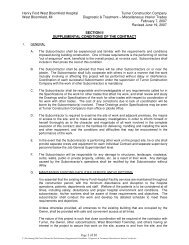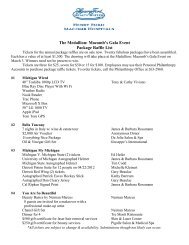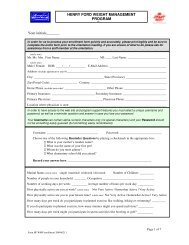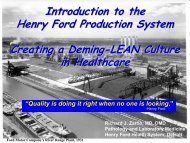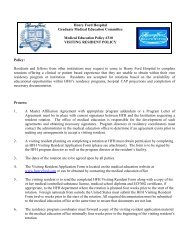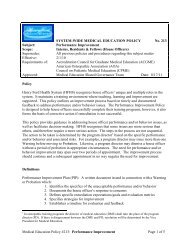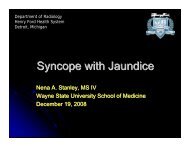Henry Ford Production System
Henry Ford Production System - Henry Ford Health System
Henry Ford Production System - Henry Ford Health System
- No tags were found...
Create successful ePaper yourself
Turn your PDF publications into a flip-book with our unique Google optimized e-Paper software.
<strong>Henry</strong> <strong>Ford</strong> <strong>Production</strong> <strong>System</strong><br />
Why Are We here?
Introduction<br />
Goal<br />
• To convey & adopt the Toyota<br />
<strong>Production</strong> <strong>System</strong> as it relates to Patient<br />
Safety in Anatomic Pathology & HFHS<br />
• To become the “Best in the Class” for<br />
defect reduction and elimination of waste.
Why are we here?<br />
• Estimated that 98,000 people will die<br />
each year in U.S hospitals from medical<br />
error, according to studies of the Institute<br />
of Medicine.<br />
• Other studies indicate that nearly as<br />
many succumb to hospital acquired<br />
infections.
Healthcare safety expert<br />
Lucian Leape<br />
compares the risk of entering<br />
an American Hospital to that of<br />
parachuting<br />
off a building or bridge.<br />
Harvard Business Review_September, 2005
Magnitude of the Problem<br />
• 99.974% Specimen ID accuracy<br />
1 Mis-ID case/month<br />
• 12/50,000 cases/year or 240 errors per million<br />
• That we know of……<br />
• = 4 sigma (goal 3.4 defects per million @ 6 sigma)<br />
• Real world correlates………………<br />
……………….next page
If 99.9% is Good<br />
Enough…..<br />
• In the next 24 hours –<br />
1,892,160 misplaced phone calls<br />
528,000 checks deducted from wrong bank<br />
accounts<br />
207,333 books shipped with wrong cover<br />
107 incorrect medical procedures performed<br />
56 incorrect drug prescriptions written<br />
12 babies will be given to wrong parents<br />
• Lab with 6.5 million tests (HFH)<br />
6,500 incorrect tests per year or 18 per day<br />
• Lab results drive 90% clinical decisions
Why look to Toyota to learn<br />
from their success of process<br />
design?<br />
• To Delight customers.<br />
• To Identify and fix system problems.<br />
• To Develop people.<br />
• To Create learning.<br />
• To Change culture.<br />
For Success. WHY REINVENT THE WHEEL?
14 principles of the Toyota<br />
Way<br />
• Principle 1<br />
Long Term Philosophy<br />
Base your management decisions on a<br />
long term philosophy, even at the expense<br />
of short term financial goals.
Principle 2:<br />
• Create continuous process flow
Principle 3:<br />
• Use the “Pull<br />
<strong>System</strong>”
Principle 4<br />
• Level the Work Load
Specimen Delivery Times<br />
Troy<br />
Total<br />
Collected<br />
600<br />
500<br />
400<br />
300<br />
200<br />
100<br />
0<br />
7:00<br />
9:00<br />
11:00<br />
13:00<br />
15:00<br />
17:00<br />
Time<br />
11/8/05-12/10/05<br />
19:00<br />
21:00<br />
23:00<br />
Taylor<br />
Lakeside<br />
NC1<br />
Fairlane<br />
W<br />
Bloomfield
Principle 5:<br />
• Build a culture of<br />
continuous<br />
improvement by<br />
stopping to fix<br />
problems to get<br />
quality right the first<br />
time.<br />
Every hand-off is<br />
correct<br />
EVERYTIME.
Principle 6:<br />
• Standardization of<br />
tasks are the<br />
foundation for<br />
continuous<br />
improvements and<br />
employee<br />
empowerment
Principle 7:<br />
• Use Visual controls<br />
so no problems are<br />
hidden.<br />
When problems remain<br />
hidden they are<br />
neither shared nor<br />
resolved.
Principle 8:<br />
• Use only reliable thoroughly tested<br />
technology that serves your people and<br />
process.
Rules of Work Design<br />
• Rule 1: Activities<br />
Work must be highly specified as to the<br />
content, sequence, timing, location and<br />
expected outcomes.
Rules of Work Design<br />
• Rule 2: Connections<br />
Connections between customers and<br />
suppliers must be highly specified, direct,<br />
with a clear yes-or<br />
or-no way to send<br />
requests and receive responses.
Rules of Work Design<br />
• Rule 3: Pathways<br />
The pathway for every product and<br />
service must be predetermined, simple<br />
but, highly specified, and direct-no loops<br />
or forks.
Rules of Work Design<br />
• Rule 4: Improvements<br />
Improvements are made using the scientific<br />
method, with guidance from a teacher as close<br />
as possible to the front line, aiming towards<br />
THE IDEAL<br />
by teaching people how to solve difficult<br />
problems.<br />
Many small, rapid process improvements made<br />
quickly after careful study. Effects analyzed.
Conclusion: Expectations<br />
of the HFPS<br />
Specimens & Resulting Diagnoses<br />
• Are defect free with quality the customer<br />
expects.<br />
• Can be delivered by one request at a time.<br />
• Can be supplied and delivered immediately.<br />
• Can be produced without waste of materials,<br />
labor or energy.<br />
• Can be produced in a work environment that is<br />
safe, physically, emotionally and professionally<br />
for every employee.
Rita D’Angelo<br />
Anjna Gandhi<br />
Anjna Gandhi<br />
Azadeh Stark<br />
Pathology<br />
Quality<br />
Management<br />
Deb Chapman<br />
Mark Tuthill, Michele Westcott,<br />
Barb Basberg, Jackie Ribbentrop<br />
Judy Shipley<br />
Linda Cardine<br />
Azadeh Stark, Ruan Varney




